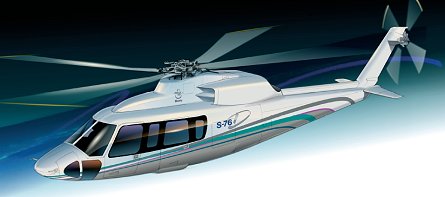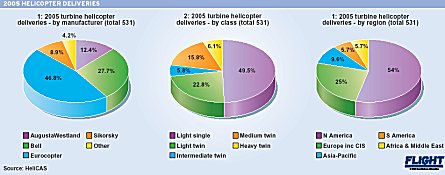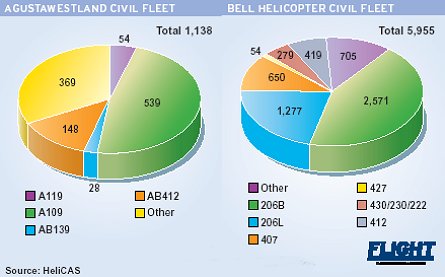A resurgent commercial helicopter market sees Eurocopter leading in revenue terms while privately- owned Robinson tops the table in delivery numbers
Commercial helicopter deliveries increased again last year, as the recovery in the civil market continued. Final figures for 2005 are not yet in from all manufacturers but, according to Flight’s HeliCAS database, a healthy 531 turbine helicopters were civil-registered last year. The leading helicopter makers also report strong order backlogs and are planning higher production rates this year.

© SIKORSKY
While the helicopter industry is riding the same post-9/11 economic recovery that is boosting other sectors of commercial aerospace, it is also seeing strong growth in the offshore support sector, which is finally re-equipping after years of operating ageing but depreciated helicopters. Growth in the law enforcement and emergency medical service sectors is also a playing a part.
AGUSTAWESTLAND
Finmeccanica company AgustaWestland bought out Bell Helicopter’s 25% stake in the medium twin-turbine AB139 in November, in a move to improve support and increase sales. Instead of Bell assembling the helicopter in Amarillo, Texas as originally planned, AgustaWestland is expanding its Agusta Aerospace (AAC) subsidiary in Philadelphia, Pennsylvania to accommodate production of the AB139 for the North American market. AAC already manufactures the single-turbine A119 and US production of the AB139 is to begin by the end of 2006.

AgustaWestland, based at Cascina Costa, Italy, is the second largest helicopter manufacturer in revenue terms with sales of €2.54 billion in 2004, but around 90% of its business is defence. Civil sales are growing on increased production of the A109 and the AB139, for which the company has some 150 orders. Revenues from commercial customer support are also growing, Finmeccanica says.
Full ownership of the 6.4t AB139 gives AgustaWestland a commercial line-up of five helicopters which includes the 2.7t A119 Koala, 3t A109E Power and stretched 3.2t A109S Grand light twins, 5.4t AB412 medium twin and 14.6t triple-turbine EH101.
An increase in gross weight for the Pratt & Whitney Canada PW206C-powered A109 Power to 3t, providing 150kg more payload, was approved in June last year. In the same month, the Grand, with longer cabin and more powerful PW207C engines, was certificated and the first US-manufactured A119 was flown by AAC. An increase in the AB139’s maximum gross weight to 6.4t, providing a 400kg higher useful load, was then certificated in October.
Rotorsim, a joint venture between AgustaWestland and CAE, is installing a Level D full-flight simulator for the AB139 at its Sesto Calende, Italy training centre, to be operational by year-end. The centre already operates an A109 simulator.
BELL/AGUSTA AEROSPACE
Although it has assumed full ownership of the AB139, AgustaWestland remains part of the Bell/Agusta Aerospace (BAAC) joint venure and is expected to raise its stake in the BA609 civil tiltrotor programme from 25% to 40% by increasing its investment during development.

First flown in March 2003, the BA609 made its first transition to aeroplane mode in July last year, subsequently reaching a speed of 255kt. AgustaWestland has assembled the second BA609 prototype and is scheduled to begin flight-testing in Italy later this year. Certification is expected by the end of the decade.
BELL HELICOPTER
A rapid recovery in commercial business is underway at Bell Helicopter Textron, with last year’s orders up by more than 40% over 2004 and year-end backlog up by more than 70%. Goals for 2006 include an increase in commercial deliveries of more than 50% over the 147 delivered in 2005, according to HeliCAS.
The backlog excludes 149 orders, worth $685 million, for Bell’s latest commercial product, the Model 429 light twin. The all-new 429 will fly for the first time later this year, with deliveries to begin at the end of 2007. Bell is also developing the re-engined Model 407X light turbine single for delivery in 2007.
Commercial business accounted for about 45% of Bell’s $2.88 billion in sales last year, split roughly equally between aircraft deliveries and aftermarket support. Bell predicts a 10% increase in revenues this year and more than $3.5 billion in sales by 2008, due in part to higher commercial deliveries, spares and support.
Bell is revamping its entire commercial line-up, which consists of the Model 206B-3, 206L-4 and 407 light turbine singles, Model 427 and 429 light twins, Model 430 intermediate twin and two medium helicopters, the single-turbine Model 210 – a remanufactured and civil-certificated UH-1H Huey - and the Model 412 twin.

A 70kg payload increase for the 1.4t 206B-3 was approved in 2004. Improvements to the 2.7t 407 to increase reliability and reduce operating costs were certificated at the same time. The 210 was certificated in July last year and customer deliveries began in November. A 95kg increase in load for the 5.4t 412 will be introduced this year, along with a health and usage monitoring system.
The 407X is re-engined with the 925shp Honeywell HTS900 turboshaft, providing a 15% increase in power, 5% reduction in specific fuel consumption and 50% longer time between overhauls. This will provide an increase in hot-and-high useful load of up to 180kg. The 407X also comes with integrated glass-cockpit avionics. Flight tests begin early this year, leading to certification and deliveries in 2007.
The eight-seat 429 is the first in Bell’s Modular Affordable Product Line (MAPL) family of light helicopters. The next in the series, which includes the five-seat Model 351 light single and eight-seat Model 382 light twin, are planned for certification and delivery by the end of the decade. The 429 introduces the wider MAPL cabin, which will be “deplugged” for the five-seat helicopter and features wide side doors and clamshell rear doors. Other MAPL technologies in the 429 include an integrated cockpit, advanced main rotor blades and reduced-noise tailrotor.
ENSTROM HELICOPTER
The resurgence of small US helicopter-maker Enstrom continues, although the company had to order operators to remove new elastomeric dampers from the main rotor of its Model 480B light turbine single last year after an accident believed to have been caused by ground resonance. Enstrom is working with supplier Lord to recertificate the dampers in the 1.4t 480B – nine of which were delivered last year, according to HeliCAS – and later in the 1.2t 280FX and F28F piston singles.
EUROCOPTER
European manufacturer Eurocopter held on to pole position in 2005, in terms of both total revenues and commercial helicopter deliveries. Sales increased 15% to €3.21 billion, while the company took orders for 401 civil and military helicopters – up from 332 in 2004 - and delivered 250 commercial machines, according to HeliCAS.
Including military variants, orders were placed last year for 44 EC120 light turbine singles, 193 of the AS350/A355/EC130 family of light singles and twins, 87 EC135 and 20 EC145 light twins, 25 of the AS365/EC155 family of intermediate twins and 14 of the AS322/EC225 family of medium-heavy twins.
Eurocopter also signed an agreement with China’s AVIC II covering joint development and production of the EC175, a 6t-class civil helicopter. The five-year development programme will begin this year, leading to a first flight in 2009 and certification and first deliveries in 2011. Each of the companies will invest €300 million and share production 50:50, each with its own assembly line. The EC175 is aimed at a market estimated at 800 helicopters over 20 years.
China began licence production of the Dauphin in 1980 and, in 1992, became an industrial partner in the EC120 programme. Since 2004 the EC120 has been assembled in Harbin for the domestic market as the HC120. Eurocopter forecasts China will require about 300 helicopters between 2005 and 2015.
The EC175 will fill a gap in Eurocopter’s otherwise wide commercial product range, which comprises the 1.7t EC120B, 2.25t AS350B2/B3 and 2.4t EC130B4 light singles; 2.6t AS355N, 2.85t EC135P2/T2 and 3.35t EC145 light twins; 4.3t AS365N2/N3 and 4.9t EC155B1 intermediate twins; and heavier 8.6t AS322L1, 9.3t AS332L2 and 10.4t EC225 twins.
Eurocopter is also establishing a series of subsidiaries around the world to increase its market penetration. Eurocopter Japan was opened in October last year, following selection of the EC225 to transport the Japanese emperor and foreign heads of state. A month earlier, long-established American Eurocopter received US Federal Aviation Administration approval to manufacture the AS350B2 and B3 in Columbus, Mississippi. Initially, the new plant will build some 30 helicopters a year, as well as manufacturing parts and subassemblies for the AS355 and AS365.
Helisim, a training joint-venture between Eurocopter and Thales, will introduce a Level D full-flight simulator for the EC225 and EC725 military version in 2007. The training centre in Marignane, France already operates AS365N2/EC155B1 and AS322L1/L2 full-flight simulators.
HINDUSTAN AERONAUTICS
Bangalore, India-based HAL began deliveries of the civil variant of its Dhruv 5.5t-class twin-turbine helicopter in 2005, but suffered a setback in January when one force-landed after a tailrotor failure. The malfunction was traced to a flaw in the composite material used to manufacture the tailrotor blade and only affected the batch of 20 helicopters now in production, so the grounding was lifted.
The affected helicopter was one of two ordered early in 2005 by the state government of Jharkand. The state government of Karnataka also agreed to lease a Dhruv for VIP duties. In June last year, India’s Oil and Natural Gas Corporation ordered three Dhruvs for offshore operations, taking delivery of the first helicopter in August, and a Dhruv has been leased by the Israeli government for VIP transport.
HAL is developing upgraded versions of its Cheetah and Chetak single-turbine helicopters, re-engined with the Turbomeca TM333 turboshaft powering the Dhruv. The five-seat Cheetal – a Cheetah with TM333-2M2 engine – first flew in February 2003, while the seven-seat Chetan – a Chetak with the same digitally controlled engine – first flew in February 2005. Both offer greater hot-and-high performance.
KAMAN AEROSPACE
Kaman hoped to restart production of its K-Max external-lift helicopter at the end of 2005 following certification of a firefighting variant, the FireMax. The company delivered he last aircraft in inventory in September 2004, and has been working to assemble a package of orders sufficient to relaunch production.
The FireMax carries a 2,660-litre (700USgal) fixed-tank firefighting system developed by Bend, Oregon-based Kawak Aviation Technologies. Flight testing began in June last year after Kaman certificated an increase in maximum gross weight for the single-seat, single-engined K-Max, to 3,175kg. Many of the 27 K-Maxes in service are expected to be retrofitted to carry the tank system.
KAMOV
Coaxial-rotor specialist Kamov continues to deliver the 3.4t Ka-226 light twin-turbine helicopter and 11t Ka-32 heavy twin to civil customers inside and outside Russia. Spanish operator Helisureste will receive a further four Ka-32A11VS helicopters this year, for firefighting, and Kamov is pursuing certification in other countries to bolster international sales, having gained approvals in Mexico and South Korea in 2005.
Deliveries of the Ka-226 began in June 2004 against an order from Russian energy giant Gazprom for 22 helicopters to be delivered by 2007. The helicopter has also entered service with the aviation branch of Russia’s federal security service. Kamov is flight-testing a Ka-226 re-engined with 670shp Turbomeca Arrius 2G2s, replacing the 450shp Rolls-Royce 250-C20Rs, and plans to test a version with Ukrainian Progress AI-450 turboshafts.
KAZAN HELICOPTERS
Kazan, based in the Russian republic of Tartarstan, is slowly ramping up production of its first indigenous design, the 3.3t Ansat light turbine twin. The Ansat, powered by Pratt & Whitney Canada PW207K engines, received Russian certification in December 2004, and five were delivered last year. Customers include South Korea and the government of Tartarstan.
Kazan manufactures the 13t-class Mi-17V5 transport and Mi-172 passenger helicopters and is developing the 15.6t Mi-38 to replace the widely used Mi-8 and Mi-17. The first prototype Mi-38 has been in flight-test since 2003 and the second is under construction. Certification and first deliveries are planned for 2008-9. The Mi-38 is powered by two Pratt & Whitney/Rus PW127T/S turboshafts.
MD HELICOPTERS
MD Helicopters (MDHI) is under new ownership – again – after New York private investment firm Patriarch Partners acquired a controlling interest from Netherlands-based RDM in July last year. RDM purchased the former Hughes, and later McDonnell Douglas, light helicopter business from Boeing in 1999, but MDHI ran into serious financial difficulties caused by delays in certificating an increased gross-weight version of the MD 902 Explorer light turbine twin.
The new owner’s first priority was to restart the supply chain, which had been shut for a year due to MDHI’s failure to pay suppliers. The main obstacle to resuming production was removed in November, when the company negotiated a long-term supplier agreement with Kaman Aerospace, which makes the Explorer’s main rotor. In September, MDHI announced new orders, for three MD 520Ns and one MD 600N light turbine singles.
PZL-SWIDNIK
Poland’s PZL-Swidnik hopes to deliver the first SW-4 light-single turbine helicopter into the potentially lucrative CIS market by year end, after receiving Russian certification in July. Deliveries of the 1.8t SW-4 to the Polish air force began in December 2004. The Swidnik-based company also produces the 3.35t Mi-2 light twin and the Kania, a re-engined version powered by Rolls-Royce 250-C20Bs in place of the PZL GTD-350 turboshafts. The company also manufactures the W-3 Sokol “medium-light” twin.
ROBINSON HELICOPTER
Privately owned Robinson did it again in 2005, producing more helicopters than any other manufacturer. The company delivered 806 piston-single helicopters last year – 243 two-seat R22s and 563 four-seat R44s – up from 690 in 2004 and the most civil helicopters produced by one company in one year. Milestones included delivery of the 4,000th R22 in December.
ROSTVERTOL
Rostov-based Rosvertol is to become part of a Russian helicopter holding company this year, along with Mil Moscow Helicopter Plant, Kazan Helicopters and Ulan-Ude Aviation Plant – all of which produce Mil designs. Kamov will also join the group, which is expected to have annual sales of at least $400 million. Rosvertol manufactures the 56t Mi-26T heavylift helicopter and is developing the upgraded 3.7t Mi-2A light turbine twin and the 1.3t Mi-60MAI piston single.
SIKORSKY AIRCRAFT
Sikorsky has embarked on the rapid growth of its commercial and military helicopter manufacturing and support business. Sales rose almost 12% last year to $2.8 billion, and a percentage increase in the “mid-teens” is forecast for this year.
The acquisition of Schweizer Aircraft in 2004 added light piston and turbine singles to Sikorsky’s portfolio but the major growth engine is the recovery in the civil market. Re-equipping offshore operators is driving orders for the 5.3t S-76 medium twin and 11.9t S-92 medium-heavy twin. Most of the 20-plus S-92s delivered so far have gone to the offshore sector.
Sikorsky received certification for the latest S-76C++ version in December and immediately began deliveries against a backlog of more than 60 orders. The C++ features uprated Turbomeca Arriel 2S2 engines, inlet barrier filters, Quiet Zone main gearbox, new health and usage management system and a new interior in the corporate version.
The C++ provides an additional 160kg of hot-and-high payload and will remain in production until the improved S-76D is available in 2008. The D model will have more powerful Pratt & Whitney Canada PW210 engines; new composite main rotor blade, quiet tail rotor and rotor ice protection system and Thales TopDeck integrated flightdeck. The Category A hot take-off capability will increase by almost 455kg compared with the S-76C+.
Schweizer continues to produce the 300C/CBi piston singles and the 1.2t 333 turbine single but the company has also become the rapid-prototyping centre for Sikorsky and is building the X2 Technology coaxial-rotor high-speed helicopter demonstrator that is due to fly at year-end.
GRAHAM WARWICK / WASHINGTON DC
Source: Flight International



















